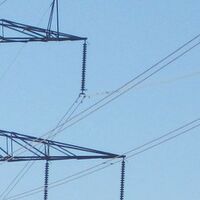IT:Key:wires
| Descrizione |
|---|
| Numero di fili per cavo di alimentazione. "single" (1), "double" (2), "triple" (3) or "quad" (4). |
| Gruppo: Power |
| Applicabile agli elementi |
| Combinazioni utili |
| Stato: in uso |
| Strumenti |
Se comprendi l'originale in aiuta a completare questa traduzione in italiano. Leggi le istruzioni su come tradurre questa wiki.
Sembra che nessuno stia lavorando a questa traduzione al momento, se vuoi puoi prenderla in carico tu.
Per descrivere il numero di fili (o meglio: sub-conduttore) per cavo di alimentazione (o meglio: fascio di conduttori) di una linea elettrica aerea.
Storia
Le linee di trasmissione ad alta tensione spesso utilizzano fasci di conduttori (cavi) ciascuna da due o più singoli sub-conduttori (fili) separate da distanziatori. Questo ha due scopi principali:
- Reduction of corona discharges. The strong electric field around a conductor can cause ionisation of the surrounding air. This may result in signicant power losses and audible noise and it is therefore important to limit such coronal discharges. The electric field can be reduced by increasing the effective diameter of the conductor. A conductor bundle will behave similarly to a single conductor having a diameter roughly corresponding to the diameter of the bundle.
- Mitigation of skin effect. AC current tend to flow at the surface of conductors. At 50 Hz the current cannot penetrate more than approximately 1 cm into the conductor. It is therefore inefficient to increase the diameter of thick conductors to reduce the electric resistance. A better way to increase the current capacity is to use bundled conductors. A conductor bundle having multiple thin sub-conductors will have a lower resistance than a single solid conductor having an equivalent cross section.
Conductor bundles are normally used at voltages above 200 kilovolt to limit corona losses but may also be used at lower voltages to increase the current capacity of the line.
Valori
Possibili valori sono:
- Un filo (no fascio): wires=single
- Due fili: wires=double
- Tre fili: wires=triple
- Quattro fili: wires=quad
Altri valori sono creati aggiungendo la parola 'fold' dopo il numero:
- Cinque fili: wires=fivefold
- Otto fili: wires=eightfold
Esempi
La foto sulla destra mostra un esempio di due fili wires=double. Vedi tre cavi ognuno di due fili.
| count | Figura | tag |
|---|---|---|
| 1 |  |
wires=single |
| 2 |  |
wires=double |
| 3 |  |
wires=triple |
| 4 |  |
wires=quad |
| 5 |  |
wires=fivefold |
| 6 |  |
wires=sixfold |
| 8 |  |
wires=eightfold |
Altri valori associabili
Il numero di cavi della linea è taggato con cables=* (qui gli scaricatori non contano). Per distinguere cavi dai fili usa la semplice regola:
- Fili non sono isolati tra di loro, ma isolati dal pilone.
- Cavi sono isolati tra di loro e dal pilone.
- Gli scaricatori non sono isolati dal pilone
Una nota sulla terminologia
I nomi delle chiavi wires=* ecables=* sono stati una scelta un po' sfortunata. Il miglior termine per "filo" è sub-conductor (IEV ref 466-10-21) di un conductor bundle (IEV ref 466-10-20). Un conduttore singolo (IEV ref 466-10-19) corrisponde a wires=single. Lo stesso vale per twin bundle, triple bundle e quad bundle che corrispondono a wires=double, wires=triple e wires=quad, rispettivamente. Vedi anche Wikipedia on conductors.
